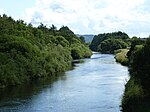Methven Junction railway station
Disused railway stations in Perth and KinrossFormer Caledonian Railway stationsPerth and Kinross railway station stubsRailway stations in Great Britain closed in 1951Railway stations in Great Britain opened in 1866 ... and 1 more
Use British English from January 2018
Methven Junction railway station opened in 1866, following the extension of the already existing Perth, Almond Valley and Methven Railway line which terminated in the village of Methven to the north. This new line, operated by the Crieff and Methven Junction Railway continued westwards from this junction through Balgowan, Madderty, Abercairney, Innerpeffray and finally, Crieff. Following the closure of Methven Station on 27 September 1937, Methven Junction was renamed 'Methven Junction Halt' until its own closure as a passenger station on 1 October 1951.
Excerpt from the Wikipedia article Methven Junction railway station (License: CC BY-SA 3.0, Authors).Methven Junction railway station
Culdeesland Road,
Geographical coordinates (GPS) Address External links Nearby Places Show on map
Geographical coordinates (GPS)
| Latitude | Longitude |
|---|---|
| N 56.4015 ° | E -3.5763 ° |
Address
Methven Junction
Culdeesland Road
PH1 3QE
Scotland, United Kingdom
Open on Google Maps




